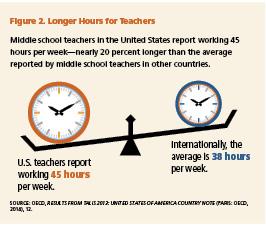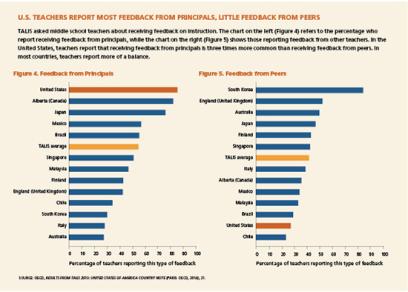For years now, educators have looked to international tests as a yardstick to measure how well students from the United States are learning compared with their peers. The answer has been: not so well. The United States has been falling further behind other nations and has struggled with a large achievement gap.
Federal policy under No Child Left Behind (NCLB) and the U.S. Department of Education’s “flexibility” waivers has sought to address this problem by beefing up testing policies—requiring more tests and upping the consequences for poor results, including denying diplomas to students, firing teachers, and closing schools. Unfortunately, this strategy has not worked. In fact, U.S. performance on the Program for International Student Assessment (PISA), conducted by the Organization for Economic Cooperation and Development (OECD), declined in every subject area between 2000 and 2012—the years in which these policies have been in effect.
Now we have international evidence about something that has a greater effect on learning than testing: teaching. The results of the Teaching and Learning International Survey (TALIS),1 released this past summer by the OECD, offer a stunning picture of the challenges experienced by American teachers, while providing provocative insights into what we might do to foster better teaching—and learning—in the United States.
In short, the survey shows that American teachers today work harder under much more challenging conditions than teachers elsewhere in the industrialized world. They also receive less-useful feedback, receive less-helpful professional development, and have less time to collaborate to improve their work. Not surprisingly, two-thirds feel their profession is not valued by society—an indicator that the OECD finds is ultimately related to student achievement.
Though it has been conducted since 2008, 2013 was the first time the United States participated in TALIS, which surveyed more than 100,000 lower secondary school teachers and school leaders in 34 jurisdictions worldwide. Although U.S. participation rates fell just below the minimum for full inclusion in the comparative report, the OECD prepared a U.S. country report. These data tell an important story.
U.S. Teachers Face More Poverty, Larger Class Sizes, Longer Days
Nearly two-thirds of U.S. middle school teachers work in schools where more than 30 percent of students are economically disadvantaged (see Figure 1). This is by far the highest rate in the world and more than triple the average TALIS rate. The next countries in line after the United States are Malaysia and Chile. Ignored by our current education policies are the facts that nearly one in four American children lives below the poverty line and a growing number are homeless,2 without regular access to food or healthcare, and stressed by violence and drug abuse around them. Educators now spend a great deal of their time trying to help children and their families manage these issues,3 while they also seek to close skill gaps and promote learning.
(click image for larger view)
Along with these challenges, U.S. teachers must cope with larger class sizes (27 students per class versus the TALIS average of 24). As shown in Figures 2 and 3, they also report spending many more hours than teachers in any other country directly instructing children each week (27 hours per week versus the TALIS average of 19). And they work more hours in total each week than their global counterparts (45 hours per week versus the TALIS average of 38), with less time in their schedules for planning, collaboration, and professional development. This schedule—a leftover from factory-model school designs of the early 1900s4—makes it harder for our teachers to find time to work with their colleagues on creating great curriculum and learning new methods, to mark papers, to work individually with students, and to reach out to parents.
(click image for larger view)
(click image for larger view)
Partly because of the lack of time to observe and work with one another, U.S. teachers report receiving much less feedback from their peers than do their counterparts in other countries (see Figures 4 and 5), which research shows is the most useful tool for improving practice.5 They also report receiving less-useful professional development than their global counterparts. One reason for this, according to our own Schools and Staffing Survey conducted by the Department of Education, is that, during the NCLB era, more-sustained learning opportunities reverted back to the one-shot, top-down, “drive-by” workshops that are least useful for improving practice.6
(click image for larger view)
Policy Implications
The picture is very different in countries that rank highly both in the TALIS survey and in student achievement on international tests. Here are some policy lessons we can learn from these high-achieving nations:
Address inequities that undermine learning: Every international indicator shows that the United States supports its children less well than do other developed countries, which offer universal healthcare and early childhood education, as well as income supports for families. Evidence is plentiful that when children are healthy and well-supported in learning in the early years and beyond, they achieve and graduate at higher rates.7 The latest PISA report also found that the most successful nations allocate proportionately more resources to the education of disadvantaged students, while the United States allocates less.
It is time for the United States finally to equalize school funding, address childhood poverty as it successfully did during the 1970s, institute universal early care and learning programs, and provide the wraparound services—healthcare, before- and after-school care, and social services—that ensure children are supported to learn. A bill introduced in Congress this past summer by Senators Jack Reed (D-RI) and Sherrod Brown (D-OH),8 with a companion bill introduced by Representative Marcia Fudge (D-OH)—the Core Opportunity Resources for Equity and Excellence Act9—would make headway on the school resource issues that are essential for progress.
Value teaching and teacher learning: Countries where teachers believe their profession is valued show higher levels of student achievement. Nations that value teaching invest more in high-quality professional learning—paying the full freight for initial preparation and ongoing professional development, so that teachers can continually become more capable. OECD data show that these countries also pay teachers as well as they pay other college-educated workers, while U.S. teachers earn only 60 percent of the average college graduate’s wage and receive little support for their learning.10 To recruit and retain top talent and enable teachers to help all children learn, we must make teaching an attractive profession that advances in knowledge and skill, like medicine and engineering.
Redesign schools to create time for collaboration: OECD studies show that higher-performing countries intentionally focus on creating teacher collaboration that results in more skillful teaching and strong student achievement. U.S. researchers have also found that school achievement is much stronger where teachers work in collaborative teams that plan and learn together. Teachers repeatedly confirm that opportunities to work with their colleagues often determine where they are willing to work.11
Collaboration, however, requires time as well as the will to make it happen, and this means that school staffing and schedules must be designed differently. The TALIS data show that U.S. schools generally hire many fewer teachers than schools in other countries. We need to rethink how we invest in and organize schools, so that time for extended professional learning and collaboration become the norm rather than the exception.
Create meaningful teacher evaluations that foster improvement: All U.S. teachers stated that formal evaluation is used in their schools, based on classroom observations; feedback from parents, guardians, and students; and review of test information. This is not very different from the TALIS average. What is different is the nature of the feedback and its usefulness. American teachers found the feedback they received to be less useful for improving instruction than their peers elsewhere found. Interestingly, as shown in Figures 4 and 5, U.S. teachers received much more of their feedback from busy principals (85 percent versus the TALIS average of 54 percent) and much less from other teachers (27 percent versus the TALIS average of 42 percent), who can generally offer more targeted insights about how to teach specific curriculum concepts and students.
In addition, the feedback from test data is different across countries. Most tests in other countries are open-ended measures scored by teachers, usually internal to the classroom or, occasionally, standardized across schools (typically in one or two grade levels). The United States is the only country in which students are tested annually with external, multiple-choice standardized tests, with scores reduced to a value-added metric assigned to teachers.12 Aside from the wide error range found to be associated with these metrics,13 they offer no information about what students actually did, said, or thought that could help teachers improve their practice. A more meaningful system would use classroom data and feedback from peers and principals in ways that are much more focused on how to teach specific content to particular students.
* * *
We cannot make major headway in raising student performance and closing the achievement gap until we make progress in closing the teaching gap. That means supporting children equitably outside as well as inside the classroom, creating a profession that is rewarding and well-supported, and designing schools that offer the conditions for both the student and the teacher learning that will move American education forward.
Linda Darling-Hammond is the Charles E. Ducommun Professor of Education at Stanford University, where she is the faculty director of the Stanford Center for Opportunity Policy in Education and the founding director of the School Redesign Network. She is a former president of the American Educational Research Association and a member of the National Academy of Education. A version of this article first appeared in the Huffington Post on June 30, 2014.
Endnotes
1. Organization for Economic Cooperation and Development, TALIS 2013 Results: An International Perspective on Teaching and Learning (Paris: OECD, 2014).
2. “Selected Economic Characteristics,” in U.S. Census Bureau, 2013 American Community Survey 1-Year Estimates, table DP03; and Roy Grant, Delaney Gracy, Grifin Goldsmith, Alan Shapiro, and Irwin E. Redlener, “Twenty-Five Years of Child and Family Homelessness: Where Are We Now?,” in “Homelessness and Public Health,” supplement, American Journal of Public Health 103, no. S2 (2013): e1–e10.
3. Prudence L. Carter and Kevin G. Welner, eds., Closing the Opportunity Gap: What America Must Do to Give Every Child an Even Chance (New York: Oxford University Press, 2013).
4. Linda Darling-Hammond, The Flat World and Education: How America’s Commitment to Equity Will Determine Our Future (New York: Teachers College Press, 2010).
5. Ruth Chung Wei, Linda Darling-Hammond, and Frank Adamson, Professional Development in the United States: Trends and Challenges (Dallas: National Staff Development Council, 2010).
6. Wei, Darling-Hammond, and Adamson, Professional Development in the United States.
7. Clive R. Belfield and Henry M. Levin, eds., The Price We Pay: Economic and Social Consequences of Inadequate Education (Washington, DC: Brookings Institution, 2007); and Richard Rothstein, Class and Schools: Using Social, Economic, and Educational Reform to Close the Black-White Achievement Gap (New York: Teachers College Press, 2004).
8. Sen. Jack Reed (D-RI), “CORE Act Seeks to Bridge Student Achievement Gap, Expand Access to Resources for Learning,” news release, June 27, 2014, www.reed.senate.gov/news/releases/core-act-seeks-to-bridge-student-achi….
9. Rep. Marcia Fudge (D-OH), “Congresswoman Fudge Introduces the Core Opportunity Resources for Equity and Excellence (CORE) Act,” news release, June 26, 2014, www.fudge.house.gov/press-statements/congresswoman-fudge-introduces-the….
10. Organization for Economic Cooperation and Development, Building a High-Quality Teaching Profession: Lessons from around the World (Paris: OECD, 2011), 13.
11. Elaine Allensworth, “Want to Improve Teaching? Create Collaborative, Supportive Schools,” American Educator 36, no. 3 (Fall 2012): 30–31.
12. Linda Darling-Hammond, Audrey Amrein-Beardsley, Edward Haertel, and Jesse Rothstein, “Evaluating Teacher Evaluation,” Phi Delta Kappan 93, no. 6 (March 2012): 8–15.
13. Linda Darling-Hammond, Getting Teacher Evaluation Right: What Really Matters for Effectiveness and Improvement (New York: Teachers College Press, 2013). See also Linda Darling-Hammond, “One Piece of the Whole: Teacher Evaluation as Part of a Comprehensive System for Teaching and Learning,” American Educator 38, no. 1 (Spring 2014): 4–13, 44.




